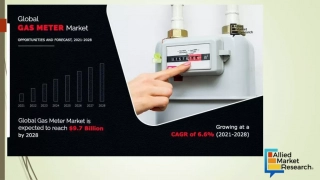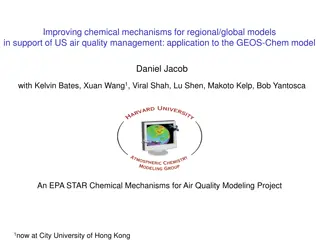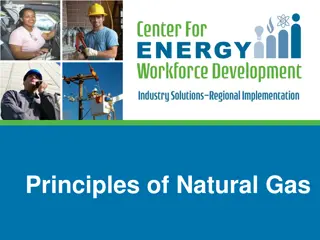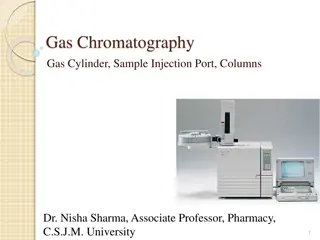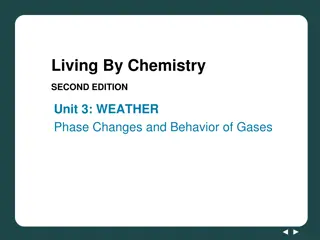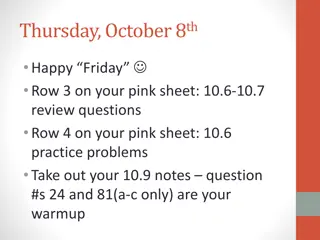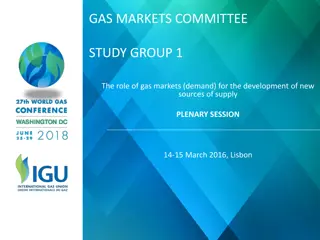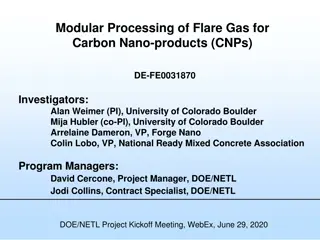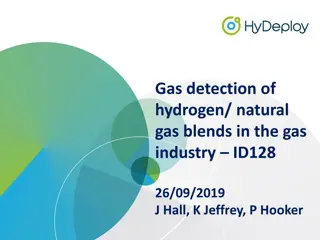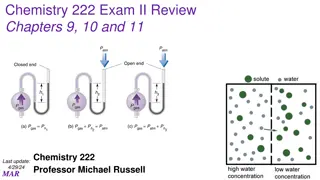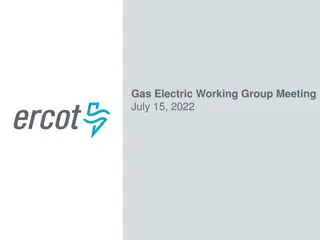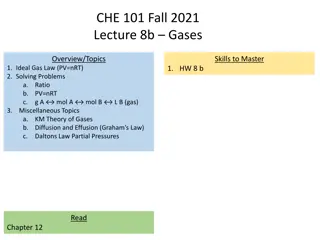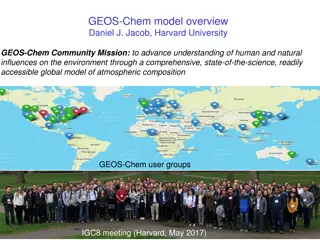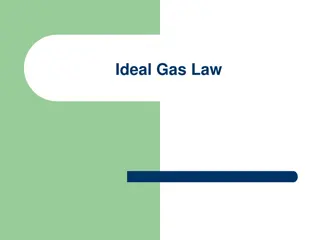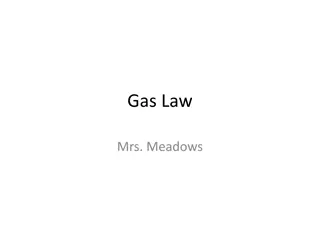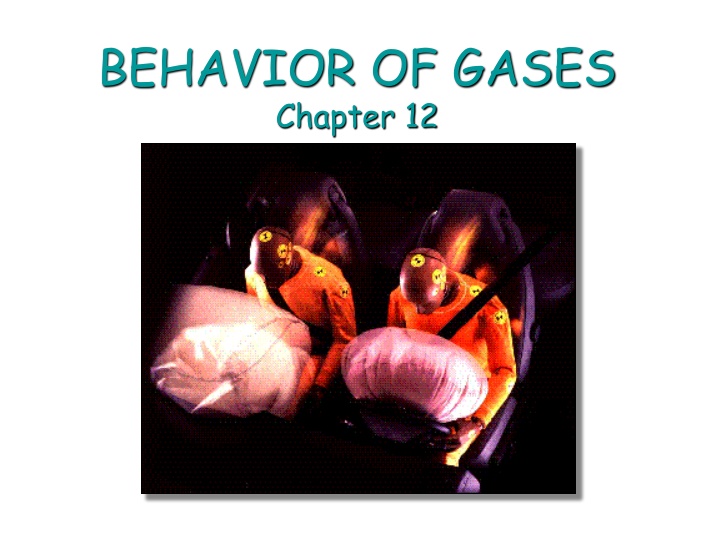
Gas Behavior and Properties: Understanding Boyle's Law and Gas Laws
Explore the behavior of gases, focusing on properties modeled using mathematical relationships involving volume, temperature, and pressure. Learn about Boyle's Law and the qualitative relationships between pressure, temperature, and volume of gas particles in a container. Practice problems and examples enhance understanding of gas behavior.
Uploaded on | 2 Views
Download Presentation

Please find below an Image/Link to download the presentation.
The content on the website is provided AS IS for your information and personal use only. It may not be sold, licensed, or shared on other websites without obtaining consent from the author. If you encounter any issues during the download, it is possible that the publisher has removed the file from their server.
You are allowed to download the files provided on this website for personal or commercial use, subject to the condition that they are used lawfully. All files are the property of their respective owners.
The content on the website is provided AS IS for your information and personal use only. It may not be sold, licensed, or shared on other websites without obtaining consent from the author.
E N D
Presentation Transcript
BEHAVIOR OF GASES Chapter 12
Properties of Gases Gas properties can be modeled using math. Model depends on V = volume of the gas (L) T = temperature (Kelvin) P = pressure (atmospheres)
Volume of Gas In a smaller container, molecules have less room to move. Hit the sides of the container more often. As volume decreases, pressure increases. (think of a syringe)
Gas Laws Here is the qualitative relationship between the pressure, temperature, and volume of a constant # of gas particles in a container: (1) ___________ Law: At a constant temperature, as the volume of a container __________ the pressure of the container will ___________. decreases Boyle s increase V___, P ___ *Example: Compressing the gas in a flexible container will _________ its volume. decrease Pressure Volume
Boyles Law How you doin ? <3 If Temperature is constant, then P1V1 = P2V2 This means that as Pressure goes up as Volume goes down. Pressure and Volume are indirectly related Robert Boyle (1627-1691). Son of Early of Cork, Ireland.
Boyles Law A bicycle pump is a good example of Boyle s law. As the volume of the air trapped in the pump is reduced, its pressure goes up, and air is forced into the tire.
Boyles Law P1 = initial pressure V1 = initial volume P2 = final pressure V2 = final volume P1V1 = P2V2 STP = standard temperature (273 Kelvin) and pressure (1 atmosphere) Pressure can be measured in atmospheres (atm), torrs (torr), millimeters mercury (mmHg) or kilopascals (kpa) Conversions: 1 atm = 760 torr = 760 mmHg = 101.325 kpa
Boyles Law Practice Problems 1. If we have 4 L of methane gas at a pressure of 1.50 x 103 mmHg. What will the pressure of the gas be if the volume is decreased to 2.5 L? P1 = V1 = P2 = V2 = 2.5 liters 1.50 x 103 mmHg = (1.05 x 103) (4) (P2) (2.5) Plug the # s into the equation and solve for P2. 4 liters ? (1.50 x 103) (4) = P2 2.5 2400 mmHg = P2
Boyles Law Practice Problems 2. You have a car with an internal volume of 12,000 L. If you drive your car into the river and it implodes, what will be the volume of the gas when the pressure goes from 1.0 atm to 1.4 atm? 1 atm = (1) (12,000) (1.4) (V2) Plug the # s into the equation and solve for V2. P1 = V1 = P2 = V2 = 12,000 L 1.4 atm ? (1) (12,000) = V2 1.4 8571.43 L = V2
Boyles Law Practice Problems If P1 and P2 are given, they must both be in the same unit. If they are not, you must make a conversion. Usually the conversion is to atm s since it is the measure of standard pressure. Make the following conversions using: 1 atm = 760 torr = 760 mmHg = 101.325 kpa Practice Problems: (1) Convert 6.5 atm to torr 760 torr 1 atm 6.5 atm x = 4940 torr (2) Convert 98 torr to mmHg 760 mmHg 760 torr 98 torr x 98 mmHg = (3) Convert 177 mmHg to atm 1 atm 760 mmHg .23 atm = x 177 mmHg
Gas Laws (continued) (2) ____________ Law: At a constant pressure, as the temperature of a container __________ the volume of the container will ___________. increases Charles s increase T___, V ___ inflate *Examples: Heating a balloon will cause it to ___________. Taking a balloon outside on a cold winter day will cause it to _____________. If you could keep a gas from condensing, you could cool it off to absolute zero and the volume of the gas would be _________! zero shrink Volume Temperature (K)
Charless Law Hey baby! You need a date? If Pressure is constant, then V1 T2 = V2 T1 This means as Volume goes up so does Temperature. This means Volume and Temperature are directly related. Jacques Charles (1746- 1823). Isolated boron and studied gases. Balloonist.
Charless original balloon Modern long-distance balloon
Charless Law V1 = initial volume T2 = final temperature V2 = final volume T1 = initial temperature V1T2 = V2T1 STP = standard temperature (273 Kelvin) and pressure (1 atmosphere) Conversions: Kelvin = degrees Celsius + 273
Charless Law Practice Problems 1. If we have 2 L of methane gas at a temperature of 40 degrees Celsius, what will the volume of the gas be if we heat the gas to 80 degrees Celsius? V1 = T2 = V2 = T1 = 40 C + 273 = 313 K 2 liters (2)(353) = (313) Plug the # s into the equation and solve for V2. (V2) 80 C + 273 = 353 K ? (2) (353) = V2 313 2.26 L = V2
Charless Law Practice Problems 1. If you have 45 L of helium in a balloon at 25 C and you increase the temperature of the balloon to 55 C, what will the new volume of the balloon be? 45 liters V1 = T2 = V2 = T1 = Plug the # s into the equation and solve for V2. 55 C + 273 = 328 K ? 25 C + 273 = 298 K = (298) (45)(328) (V2) (45) (328) = V2 298 49.53 L = V2
Gas Laws (continued) (3) ____________ Law: At a constant volume, as the temperature of a container __________ the pressure of the container will ___________. increases Guy-Lussac s increase P1T2 = P2T1 T___, P ___ *Example: Heating a rigid container causes the gas inside to move __________ which causes _________ pressure. Be careful! Too much heat will make it explode! faster more Pressure Temperature (K)
The Combined Gas Law
Combining the gas laws So far we have seen three gas laws: Bachelor #1 Bachelor #3 Bachelor #2 I m the hottest pick me! Check me out! Pick me baby! Joseph Louis Gay-Lussac Robert Boyle P1V1= P2V2 Jacques Charles V1 T2 = V2 T2 = P2 T1 P1 T1 These are all subsets of a more encompassing law: the combined gas law P1V1T2 P2V2 T1 =
The Combined Gas Law This equation combines all of the previous three laws into one convenient form. Boyles Law: Pressure and volume Guy-Lussac s Law: Pressure and temperature Combined Gas Law Charles s Law: Volume and temperature Using the Combined Gas Law requires you to have the temperature in _____________ units. The pressure and volume units can be anything as long as the initial and final units are ______ __________. the same P2 x V2x T1 P1 x V1x T2 = Kelvin (initial conditions) = (final conditions)
Standard Temperature and Pressure: (STP) Often the volume of a gas is needed at standard conditions. For scientists, this means STP . Standard temperature is ______K, and standard pressure is ____________ atmosphere (atm) 1 273 1 atmosphere (atm) = 760 Torr = 760 mmHg = 101.3 kPa = 14.7 lbs/in2 (psi) Practice Problems: 1) 80.0 mL of helium is in a balloon at 25 C. What will the new volume of the balloon be if the temp. is raised to 100 C? (Since pressure is not mentioned, it can be assumed that it was constant. You can throw it out of our equation.) P1 = ______ 80.0 mL P2 = ______ (298) (373) Plug the # s into the equation and solve for V2. =(V2) (80.0) ??? V1= ______ V2= ______ TK2= ______ 373 K 298 K V2 = 100 mL TK1= ______
Practice Problems (continued): 2)A rigid steel container is filled with neon under a pressure of 760 mm Hg and a temperature of 325 K. If the temperature is reduced to standard temperature, what will the new pressure be? P1 = ______ V1= ______ TK1= ______ TK2= ______ 325 K 273 K solve for P2. 760 mm ??? P2 = ______ (325) Plug the # s into the equation and (273) = (P2) (760) V2= ______ P2 = 638 mm Hg Volume is not mentioned, so assume it is constant. 3) A balloon at a pressure of 4.5 atmospheres, 300 K, and a volume of 35.0 liters is changed to STP conditions. What will the new volume of the balloon become? P1 = ______ 4.5 atm 35.0 L P2 = ______ 1 atm Plug the # s into the equation and solve for V2. (273) (1)(V2) (4.5)(35.0) = (300) ??? V1= ______ V2= ______ TK2= ______ 273 K 300 K TK1= ______ V2 = 143 L
Under Pressure Dalton's Law of Partial Pressures
Daltons Law of Partial Pressure What happens to the pressure of a gas as we mix different gases in the container? The ______ of each individual gas pressure equals the _______ gas pressure of the container. total sum P(total)= P1+P2+P3
Daltons Law of Partial Pressures 1) A container has oxygen, nitrogen, and helium in it. The total pressure of the container is 2.4 atmospheres. If all the partial pressures are equal to one another, what ate the partial pressures of each gas? P total = 2.4 atm 3 Total number of gases = Pgas = 2.4 atm 3 = 0.8 atm 27
Daltons Law of Partial Pressures 2) Two flasks are connected with a rubber hose. The first flask contains N2 at a pressure of 0.75 atm., and the second flask contains O2 at a pressure of 1.25 atm. When the two flasks are opened and mix, what will the pressure be in the resulting mixture? P2 = P1 = 0.75 atm 1.25 atm Ptotal = 0.75 atm + 1.25 atm = 2.0 atm 28
Daltons Law of Partial Pressures 3) A mixture of neon and argon gases exerts a total pressure of 2.39 atm. The partial pressure of the neon alone is 1.84 atm. What is the partial pressure of the argon? Ptotal = 2.39 atm P1 = 1.84 atm P2 = 2.39 atm 1.84 atm = 0.55 atm 29
DALTONS LAW OF PARTIAL PRESSURE: WATER DISPLACEMENT METHOD SAMPLE PROBLEM In a laboratory, oxygen gas was collected by water displacement at an atmospheric pressure of 726 torr and a temperature of 22 C. Calculate the partial pressure of dry oxygen. Water vapor pressure is 2.6 kPa (from table in reading packet). Convert 2.6 kPa to torr to solve.
DALTONS LAW OF PARTIAL PRESSURE: WATER DISPLACEMENT METHOD SOLUTION to Sample Problem PTOTAL = 726 torr PWATER= 19.5 torr (22 C) POXYGEN = ? POXYGEN = PTOTAL PWATER = 726 torr 19.5 torr POXYGEN = 706.5 torr PTOTAL = POXYGEN + PWATER
Daltons Law of Partial Pressures 3) A mixture of helium, neon and argon gases exerts a total pressure of 2.39 atm. What is the partial pressure of the argon if it makes up 40% of the mixutre? Ppartial pressure = Ptotal x (%of mixture) Ptotal = 2.39 atm % = 0.40 Ppartial pressure = 2.39 atm x 0.40 = 0.956 atm 32
Avogadros Hypothesis Avogadro s hypothesis states that ________ volumes of gases (under the same temp. and pressure conditions) contain _______ number of particles. If containers have the same ____, ____, and ___, then they will have the same ____ of particles regardless of the _________ of the gas particle. You might think that a small gas molecule would take up ______ space than a large gas molecule, but it ___________ at the same _________________ and ______________!! temperature pressure equal equal T P V # size less doesn t
AVOGADROS LAW The mathematical form of Avogadro s law is: V1= V2 n1 n2 SAMPLE PROBLEM 1 A sample of gas with a volume of 9.20 L is known to contain 1.225 mol. If the amount of gas is increased to 2.85 mol, what new volume will result if the pressure and temperature remain constant?
AVOGADROS LAW SOLUTION Given: V1 = 9.20 L n1 = 1.225 moln2 = 2.85 mol Solution: V2 = n2V1 = (2.85 mol) (9.20 L) = 21.4 L n1 (1.225 mol) V2 = ?
The Ideal Gas Law An equation used to calculate the __________ of gas in a container (in units of _________.) PV=nRT The units for T= __________, V = _________, n = # of moles Kelvin amount moles Liters R = Ideal Gas Constant The value of R changes depending on the unit of ____________ used in the equation: pressure R = 62.4 (mm Hg)(L)/(mole)(K) R = 8.31 (kPa)(L)/(mole)(K) R = 0.0821 (atm.)(L)/(mole)(K) R = 2.45 (in. Hg)(L)/(mole)(K)
Ideal Gases Real gases, (like nitrogen), will eventually ___________ into a liquid when the temperature gets too ____ or the pressure gets too _____. If you want a gas to act more ideally, keep the temperature _____ and the pressure ______. That way, they will act more like an ideal gas and never have a chance of _______________. The best real gas that acts like an ideal gas is __________. It doesn t condense until the temperature gets to ______K. condense low high high low condensing helium 4 Real Gas
Ideal Gas Law Ideal Gas Law SAMPLE PROBLEM 1 What pressure will be exerted by 0.400 mol of gas in a 5.00 L container at 17.0 C? Given: n = 0.400 mol V= 5.00 L T= 17.0 C + 273 = 290 K Solution: L atm P = nRT = (0.400 mol) (0.0821 mol K) (290 K) = 1.9atm V (5.00 L)
Diffusion vs. Effusion The spreading out of a gas from _______ to _____ concentrations is called diffusion. low high *Example: ___________ in a room spreads out A gas escaping through a ______ _______ in a container is called effusion. As the size of a molecule _____________, the effusion speed and diffusion rate ______________...(inverse relationship.) decrease Perfume tiny hole increases Effusion

